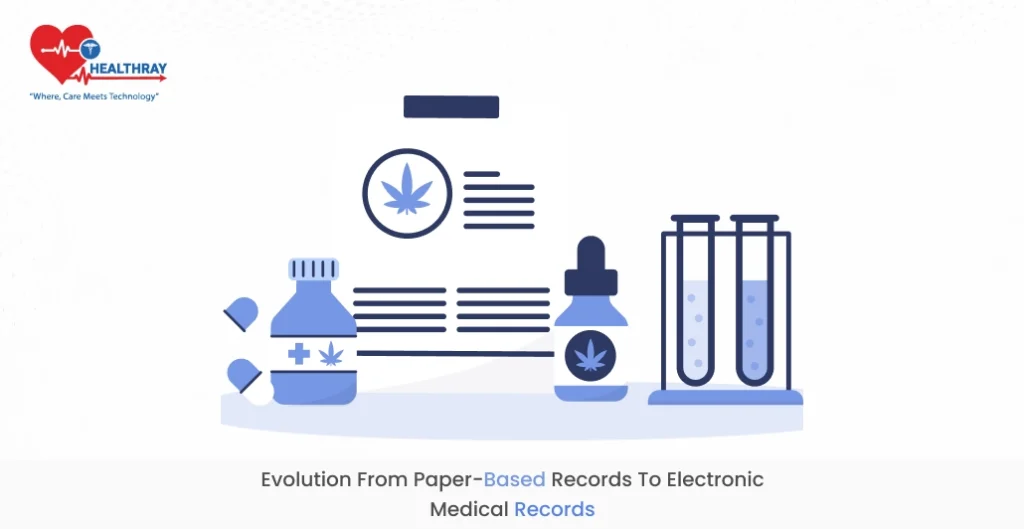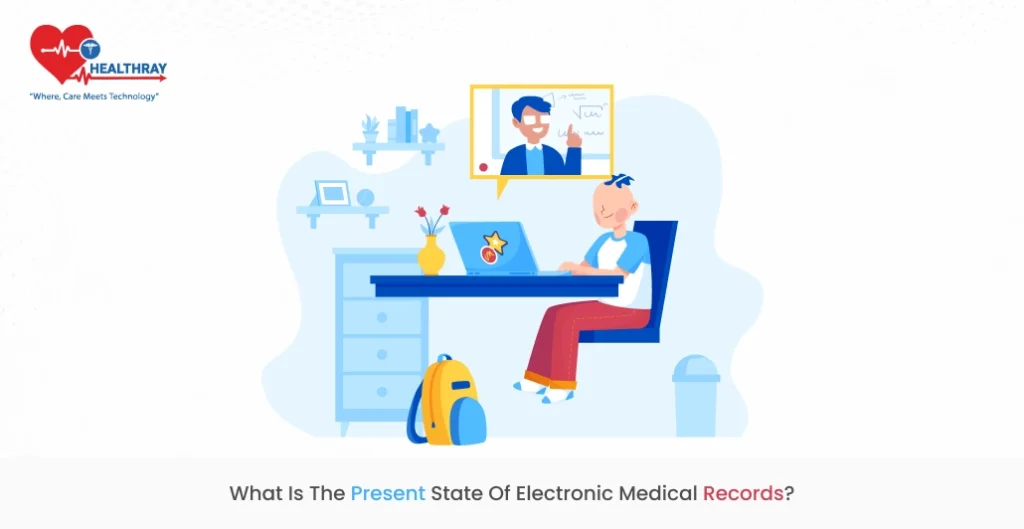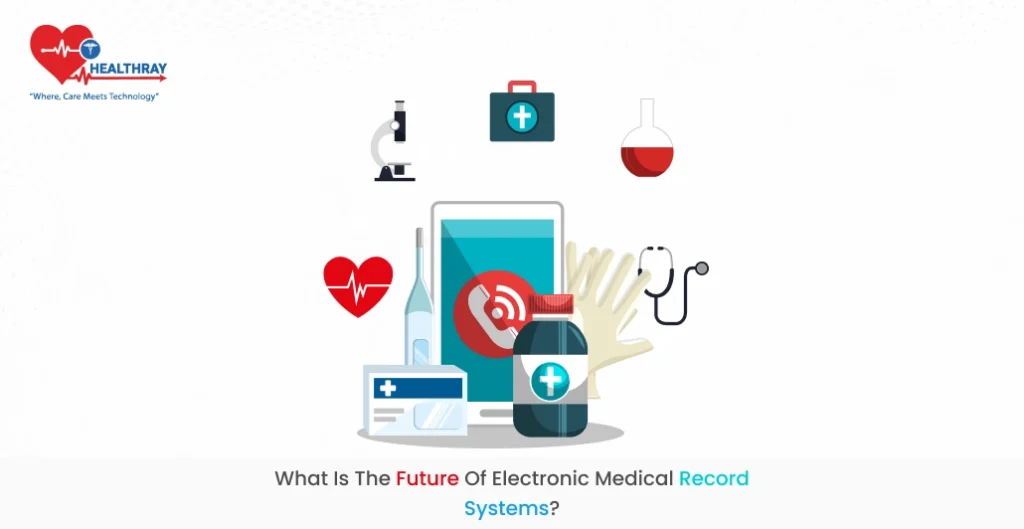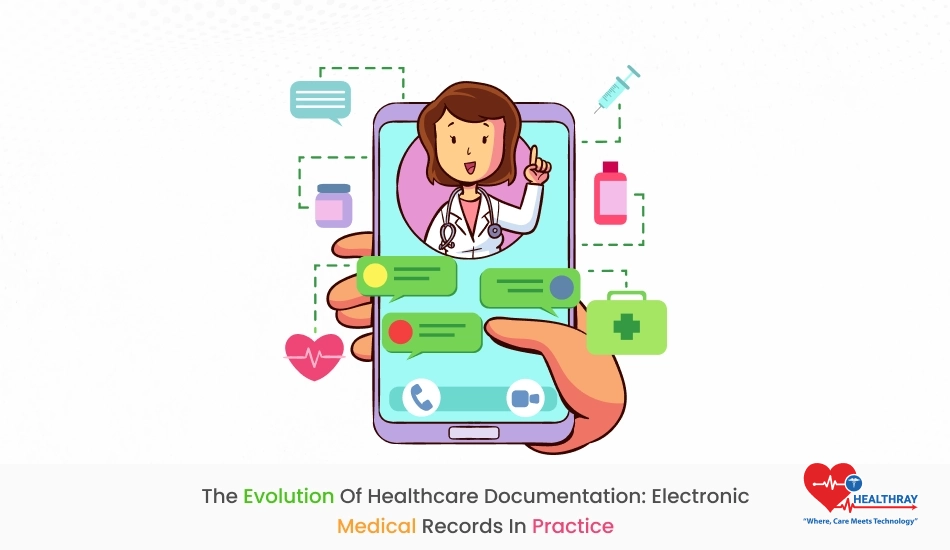Quick Summary
The shift from paper-based to electronic medical records (EMRs) is described in “The Evolution of Healthcare Documentation: Electronic Medical Records in Practice”. It draws attention to advantages such as increased effectiveness, accessibility, and data security. It also uses access limits and encryption to guarantee patient confidentiality.
Introduction
Even though the name Electronic Medical Records (EMR/EHR) Solution is relatively modern, its roots are ingrained in history. Without question, the medical field has advanced essentially in tracking patient information, from paper-based health records to modern IT systems!
Nowadays, it’s straightforward to consider electronic medical records (EMRs), sometimes called electronic health records software, to be only an alternative to paper record-keeping. We, as a well-known provider of EMR software, know differently. Since its introduction, EMR frameworks have undergone critical improvement in healthcare innovation.
The truth is that there have been many advancements in the field of healthcare data, and it has a wealthy history that electronic medical record firms have created. Hence, this has changed the management of electronic medical records. Keeping this in intellect, let’s look at EMR Software by looking at their evolution, their widespread use, and their digitization.
In the modern healthcare era, the digital version of healthcare records is necessary due to fast processing of tasks. However, the electronic medical records system is more than a recording software due to additional functionalities that are alerts, robust data security, AI transcriber, patient portal, and interoperability. Ease to have virtual communication with the licensed professionals.
In this blog article, we’ll investigate the history of EMRs, covering everything from their unique application to today’s cutting-edge advanced innovation. We’ll also discuss a number of critical turning points that have influenced care quality and availability for an extraordinary number of patients around the world. Let’s in-depth look at the comprehensive history of healthcare documentation industries.
Let’s address a pivotal query before diving into a thorough outline of the past of EMR systems: What precisely is an EMR?
What are electronic medical records?

Electronic medical records or EMRs are the digital form of paper charts. In a single computerized record, they hold the whole patient’s medical history, diagnosis, medicines, treatment plans, dates of immunizations, allergies, radiological pictures, and laboratory test results. With a centralized database that healthcare pros from different specialities and areas may access, these records speak to a tremendous leap in healthcare technology.
In 2020, more than 90% of US office-based physicians used electronic health records, according to a report from the Office of the National Coordinator for Health Information Technology.
Electronic medical records, or EMRs, replace paper charts in the documentation process, making it less demanding for medical staff to enter and recover a patient’s medical records and information. They also make it easier to quickly get patient information, which helps medical experts make well-informed choices about diagnosis and treatment. Also, EMRs may naturally screen for allergies and drug interactions, which reduces the possibility of medicine errors.
EMRs also encourage information sharing over different healthcare offices, which cultivates interoperability and coherence of care. Patients no longer have to move doctor’s offices, bring physical duplicates of their medical records with them, or have pointless tests performed while going by different specialists.
Electronic health records are an enormous step toward modernizing healthcare conveyance. EMRs help the healthcare framework operate more efficiently, give superior patient care to healthcare providers, and deliver better results by centralizing and digitizing patient information.
Evolution from paper-based records to electronic medical records

Transitioning physical documents to electronic medical documents is the long journey and we rendered the phases of transition that covers the history of healthcare documentation industries and how this industry transforms to full-fledged digitalized systems. Let’s leap into the phases of transition.
Early medical documentation
The history of Electronic Medical Record dates back to the ancient Greeks, Romans, and Egyptians. These ancient societies recorded medical information using various procedures, such as wax tablets, papyrus scrolls, and hieroglyphic writing. You ought to be mindful of the start date of electronic health records.
The clergy, who were frequently the only literate individuals in society, dealt with medical recordkeeping for most of the Medieval Ages, when EMRs were first created. Religious communities and groups transmitted medical information and they would interpret it and form it into religious works.
Specialists began keeping notebooks in the 17th century to share medical records and report their discoveries, proposals, and patient results. These notebooks were the most punctual systematic attempts to capture medical data and were a forerunner to advanced medical records.
The creation of the computerized charting system and the appropriation of standardized shapes for medical reporting improved the organization and consistency of medical records in the 19th century. Hospitals and other healthcare offices were to create frameworks for medical documentation, including standardized shortened forms and coded medical terminology.
Pre-electronic documentation
Before the development of electronic health records and until the show, paper-based frameworks, mainly utilized for medical recording. Medical experts found it challenging to quickly access patient data since, usually recorded in filing cabinets and retained in organizers or binders.
Healthcare experts record patient socioeconomics and medical histories and analyze medicines and results utilizing a variety of forms and layouts. Healthcare organizations regularly standardized to ensure exactness and consistency.
Moreover, medical documentation included advance notes, which medical experts made to record their observations, conclusions, and plans for patient care. Usually composed by hand, progress notes contained details regarding the patient’s indications, imperative signs, prescriptions, and proposed courses of therapy.
Medical documentation also contained a variety of reports, counting pathology, radiography, and laboratory and symptomatic test discoveries for expansion to progress comments. Specialized divisions habitually delivered these reports inside healthcare institutions. Also, it kept separated from the patient’s medical record.
Paper-based medical recording frameworks had several downsides, such as difficult-to-read doctor handwriting, lost or fragmented information, and inconvenient data communication with healthcare experts. These troubles may lead to misdiagnoses, errors, and delays in patient care.
Step towards digital era with our healthcare solution
Revamp your hospital facilities and embrace change for better healthcare management. Ease in managing and organizing large medical datasets leads to effective analysis. Seize the opportunity now!
Early Data Processing Systems
When computer innovation became more available in the 1960s and 1970s, created well-being record information processing frameworks. Automated administrative activities like scheduling and billing are early innovations for clinical trials. In this manner, you must comprehend the EHR timeframe.
The Regenstrief Medical Record System (RMRS), made in the 1970s by analysts at the Indiana-based Regenstrief Institute, was among the first computer-based medical record systems. RMRS Healthcare specialists may access and analyze patient data thanks to the RMRS. Additionally, it collects and protects patient information in an organized way. Thus, it supported the creation of an electronic medical record.
Dr. Lawrence Weed created the Problem-Oriented Medical Record (POMR) in the 1960s, another early framework. The Subjective, Objective, Assessment, Plan (Soap) note established the POMR, which gave healthcare suppliers a standardized strategy for recording patient information and treatment plans.
As computer innovation evolved, developed a complex electronic health record (EHR) system. These frameworks made it conceivable for medical experts to collect entire records. Also, keep track of patient information, such as demographics, medical histories, diagnoses, medicines, and treatment plans.
Nowadays, healthcare suppliers utilize the EMR standard tool. They are vital for keeping up with patient information, improving patient care, and advancing provider communication. EHR frameworks are superior to paper-based frameworks in several ways, including increased accessibility, precision. Also, it eases data sharing among healthcare professionals.
Reduced hospital expenses and enhances sustainability
Paper medical records require a number of accessories such as postage, physical documents, ink, and paper. Therefore, it increases expenses and affects the whole environment. There are various challenges to having physical records such as difficulty retrieving documents,a large number of mistakes, and tracking is almost hard.
Electronic records, the ultimate solution of all challenges and reserve trees to save the working environment. Furthermore, it improves healthy lifestyle, reserves unlimited information, and minimizes mistakes. Most importantly, it helps to track information, improve patient outcomes, and increases security.
Introduction & rise of EMR
Required of your past to comprehend electronic health records. Learning about the advancement and history of electronic health records is interesting. The popularity of EHRs is due to several components:
- Innovative developments: Technological advancements have made the digitization of medical records more reasonable and accessible. As a result, EHR selection is presently conceivable for healthcare suppliers of all sizes. Hence, created and released electronic health records software.
- Government controls: Healthcare suppliers who executed EHRs received financial incentives under the Health Information Technology for Economic and Clinical Health (HITECH) Act of 2009 in the United States. This accelerated appropriation, particularly among smaller clinics that might otherwise have required more prominent funding to buy EHRs. Hospital EHR contributes to record preservation.
- Improve efficiency : Enhances flexibility, provides a large database, saves expenses, and increases medical performances. Additionally, it increases the level of clinical productivity. Consequently, the EMR software reduces initial expenses, elevates patient coordinated care, and enhances efficiency.
- Better patient care: Electronic Health Records (EHRs) can help with superior patient care by giving medical experts moment access to patient information, encouraging more facilitated care over different providers, and reducing the possibility of medical errors.
- Savings: EHRs can help reduce the cost of printing, storing, and recovering paper-based medical records.
What is the present state of electronic medical records?

Interoperability
The interoperability of the Electronic Patient Management System has advanced in the current condition. However, troubles still exist. The smooth exchange of patient information between different frameworks, or interoperability, has expanded due to standardization activities and specialized developments. Smooth data sharing is impossible with exclusive frameworks, protection issues, and contradictions in information designs.
Although there have been a few advances toward more acknowledgment, activities like HL7’s FHIR (Fast Healthcare Interoperability Resources) endeavor to progress compatibility. Indeed, with these progressions, genuine interoperability still needs governmental activities, agreeable efforts from healthcare partners, and ongoing development to ensure that EMR Systems productively support patient care while securing privacy and data integrity.
Patient Access
Specialized advancements and legal orders are driving patient access to electronic medical records (EMRs). To make taught choices and take a dynamic part in their care, patients are beginning to ask and expect access to their wellbeing information. This access is conceivable utilizing portals and smartphone apps that give capacities for medication administration, appointment booking, and secure texting with medical experts.
Nonetheless, contrasts in healthcare circumstances and specialized capability mean that disparities in access proceed to exist. Steady work guarantee data security, enable patient instruction, and speed up access. Giving patients total access is still a key objective in the conveyance of present day healthcare.
Artificial Intelligence
Artificial intelligence (AI) developments integrated in a way that is changing electronic medical records (EMRs). By computerizing forms like data section, examination, and clinical choice support, AI is changing EMRs. Clinical documentation is progressed by natural language processing, which makes it less requesting to remove experiences from unstructured data. Based on sweeping datasets, machine learning algorithms can recognize anomalies, anticipate patient results, and customize treatment regimens.
AI-driven courses of action increase definite accuracy, streamline forms and diminish authoritative workloads. In spite of the reality that there have been engaging progressions and issues with data security. Further, calculation inclination and authoritative compliance still exist. EMR systems, collaboration, ethical thought, and continuous examination are principal to utilizing AI’s potential to move forward.
With ML algorithms, the electronic medical records system comprehends a large set of information, examines the data patterns, analyzes medical images, and predicts customer outcomes. Implemented advanced security algorithms that ease the prevention of information and enhance data privacy. Additionally, it helps to know the medicine requirement after deep analyzing of clinical documents.
Cybersecurity
Given the state of electronic medical records (EMRs), cybersecurity precautions are becoming increasingly important. Since health data is increasingly being computerized, protecting EMRs from hackers is essential. The confidentiality and integrity of medical records are regularly threatened by ransomware attacks, data breaches, and phishing schemes. Visit security surveys, access limits, and the use of powerful encryption technology are examples of basic security precautions.
Developing cybersecurity best practices awareness among healthcare personnel is essential to reducing the likelihood of human error. Collaboration between cybersecurity experts, administrative offices, and healthcare vendors is essential to ensuring that EMRs are protected against dynamic cyberattacks. Also, it maintains patient confidence in computerized healthcare systems.
Telehealth
Telehealth is bound to improve the level of care. It can grow availability whereas guaranteeing that each patient gets convenient care. The current status of electronic medical records (EMRs) and the speedy advancement of telehealth organizations are closely related. Virtual care conveyance and inaccessible discussions are conceivable.
This is happening due to the smooth integration that EMRs have made to energize telehealth platforms. Healthcare specialists may access patient records promptly, update data, and encourage care in different areas over secure connections.
Improved access to healthcare, particularly in underprivileged districts, has been made conceivable by telehealth, growing patient joy and involvement. EMR development is still being created and advanced. There are some issues like information security and security in assisting contacts. Other issues are interoperability between distinctive telehealth systems and EMRs continue to be priorities.
What is the future of electronic medical record systems?

Electronic medical record (EMR) systems can alter patient results, healthcare conveyance, and data-driven decision-making in the future. As advancement moves forward, a few vital subjects are anticipated to affect the advancement of EMR frameworks.
Interoperability will be the range of emphasis. Efforts must be made to standardize data designs and exchange techniques. It will empower smooth communication between EMR systems, healthcare providers, and other accomplices. Total patient care will be made less complex by this interoperability, making communicating health information between particular platforms and organizations simple.
Second, machine learning (ML) and artificial intelligence (AI) will essentially support progressing EMR capabilities. These progresses can analyze broad patient data to find patterns, assess conceivable health dangers, and customize treatment regimens. Healthcare specialists can concentrate more on patient care by utilizing AI-powered calculations to automate forms like pharmaceutical organization, determination support, and documentation.
There will also be a rise in the incorporation of EMR frameworks with telemedicine. Remote monitoring, virtual visits, and interviews will be made conceivable by telemedicine innovations integrated with EMRs, improving patient comfort and openness to healthcare administrations.
The focus on patient empowerment and engagement is another factor.
User-friendly interfaces, versatile access, and patient portals will be prioritized in future EMR frameworks so that individuals can effectively manage their health data, make appointments, and communicate with their healthcare suppliers.
Lastly, securing sensitive patient information in electronic medical record frameworks would require critical cybersecurity breakthroughs. To decrease the probability of information breaches and secure patient protection, more robust encryption, verification techniques, and proactive threat detection strategies will be implemented.
EMR systems’ future rests on their capacity to utilize innovations, give information security and interoperability, begin with priority, and put patients at the center of healthcare conveyance. EMR frameworks will continue to spur development and raise the standard, viability, and availability of healthcare administrations thanks to these advancements.
Want an electronic medical record system for your organization? Give Healthray a chance!
Are you looking for an electronic medical record (EMR) framework for your company? Consider giving Healthray a try! Healthray offers a total Electronic Medical Record Solutions designed to suit healthcare suppliers of all sizes. Healthray can help you increase efficiency, optimize patient care, and streamline authoritative processes.
With its user-friendly interfacing, versatile layouts, and modern data-gathering capabilities, Healthray’s EMR framework liberates healthcare suppliers to concentrate more on giving patients high-quality care. By empowering interoperability, the platform encourages smooth data transmission over different frameworks and providers.
Besides, Healthray prioritizes information security, implementing strong authentication and encryption strategies to secure private patient information. Healthray empowers businesses to interact with patients and provides simple access to medical administrations with features like patient entrances and telemedicine integration.
Select Healthray if you’re looking for an EMR framework that can increase effectiveness, boost patient results, and revolutionize healthcare delivery in your company.
Conclusion
It was astounding to see the switch from paper to electronic medical records. You must be mindful of the disadvantages of electronic medical records if you wish to understand the fundamental objective of EMRs. Healthcare experts can access complete, current medical records through electronic health records (EHRs), which makes a difference in making more educated analyses and treatment proposals. Furthermore, EMRs help healthcare specialists communicate with one another, ensuring that patients get coordinated care.
Electronic medical record (EMR) frameworks lower the chance of medical mistakes by giving medical experts quick, precise access to patient therapeutic histories, medicine data, and allergy data. To anticipate negative results, EMRs can moreover help recognize possible drug interactions and allergies.





